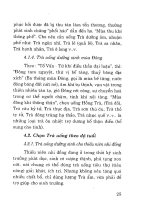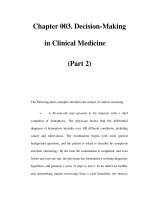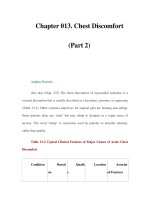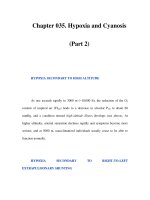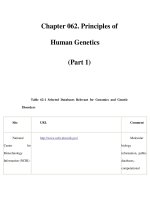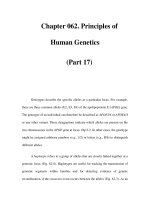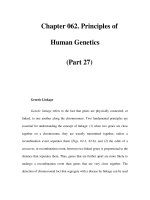BASIC HUMAN ANATOMY - PART 2 pdf
Bạn đang xem bản rút gọn của tài liệu. Xem và tải ngay bản đầy đủ của tài liệu tại đây (229.27 KB, 25 trang )
MD0006 1-15
15. In figure 1-6, three points are labeled a, b, and c, and two borders are
labeled d and e. It is correct to say that a is to b and c, b is to a
and to c, and c is to a and b. We speak of d as the border. We
speak of e as the border.
Figure 1-6. Directions (exercise 15).
MD0006 1-16
16. In figure 1-7, three portions of the arm are marked a, b, and c. The two ends
of the arm are marked d and e. The portion marked a is the third. The portion
marked c is the third. The end marked d is the end. The end marked e
is the end.
Figure 1-7. Directions upon members (exercise 16).
17. A cell is the unit of body organization.
MD0006 1-17
18. In figure 1-8, parts of a "typical animal cell" are marked with the letters a
through g. In the spaces below, provide the name of each structure.
a.
b.
c.
d.
e.
f.
g.
Figure 1-8. A "typical" animal cell (exercise 18).
Check Your Answers on Next Page
MD0006 1-18
SOLUTIONS TO EXERCISES, LESSON 1
1. Anatomy is the study of the structure of the body. (para 1-1a)
2. A broad individual: endomorph.
A slim individual: ectomorph.
A person with average build: mesomorph. (para 1-2)
3. Study of structures that cannot be seen with the unaided eye: microscopic
anatomy.
Study of relationships between functions and structures: functional anatomy.
Study of the nervous system: neuroanatomy.
Study of organ systems: gross anatomy by systems. (para 1-4)
4. The body is organized into cells, tissues, organs, organ systems, and the total
organism. (para 1-5)
5. A cell is the smallest discrete living unit of the body construction. (para 1-5a)
6. A tissue is a grouping of like cells working together. (para 1-5b)
7. An organ is a structure composed of several different tissues performing a
particular function. (para 1-5c)
8. An organ system is a group of organs performing an overall function together.
(para 1-5d)
9. The total organism is the individual human being. (para 1-5e)
10. The parts of the upper member are the shoulder, arm, forearm, wrist, and hand.
(para 1-6c(1))
11. The parts of the lower member are the hip, thigh, leg, ankle, and foot.
(para 1-6c(2))
12. One reason for studying terminology is to be successful in a medical field.
Another reason is to be able to communicate well. (para 1-7a)
13. The anatomical position is described as follows:
a. The body stands erect, with heels together.
b. The upper members are along the sides, with palms facing forward.
c. The head faces forward. (para 1-8)
MD0006 1-19
14. a. Midsagittal or median plane.
b. Sagittal plane.
c. Horizontal or transverse plane.
d. Frontal or coronal plane. (para 1-9)
15. It is correct to say that a is lateral to b and c, b is medial to a and lateral to c, and c
is medial to a and b. We speak of d as the lateral border. We speak of e as the
medial border. (para 1-10c)
16. The portion marked a is the distal third. The portion marked c is the proximal third.
The end marked d is the distal end. The end marked e is the proximal end.
(para 1-10e)
17. A cell is the microscopic unit of body organization. (para 1-12)
18. a. Ribosomes.
b. Mitochondrion.
c. Endoplasmic reticulum.
d. Nucleus.
e. Centrioles.
f. Cytoplasm.
g. Cell membrane. (fig 1-4)
End of Lesson 1
MD0006 2-1
LESSON ASSIGNMENT
LESSON 2 Tissues of the Body.
TEXT ASSIGNMENT Paragraphs 2-1 through 2-17.
LESSON OBJECTIVES After completing this lesson, you should be
able to:
2-1. Define tissue.
2-2. Name four major types of tissues.
2-3. Define epithelial tissue, connective tissue,
muscle tissue, and nervous tissue.
2-4. Given a description of epithelial tissue, matrix,
fibrous connective tissue, cartilage connective
tissue, bone connective tissue, fat connective
tissue, smooth muscle tissue, striated muscle
tissue, cardiac muscle tissue, nervous tissue,
neuron, or glia, name it.
2-5. Name four major types of connective tissue
(CT); name the characteristic cells of fibrous CT,
cartilage CT, and bone CT; and describe the
matrix of fibrous CT, cartilage CT, and fat CT.
SUGGESTION After completing the assignment, complete the
exercises at the end of this lesson. These exercises
will help you to achieve the lesson objectives.
MD0006 2-2
LESSON 2
TISSUES OF THE BODY
Section I. GENERAL
2-1. DEFINITION
A tissue is a grouping of like cells working together.
2-2. TYPES OF TISSUES
There are several major types of tissues. The most common types are epithelial,
connective, muscle, and nervous tissues. Later, this lesson will discuss each type.
2-3. TISSUES AND ORGANS
a. Tissues make up organs. An organ is a structure performing a particular
function. An organ is composed of several different tissues. Examples of organs are
the lungs and the heart.
b. In some cases, a term may be used to describe both a type of tissue and a
kind of organ. For example, we speak of bone tissue and of bones. We speak of
muscle tissue and of muscles.
Section II. EPITHELIAL TISSUES
2-4. DEFINITION
Epithelial tissue is tissue that covers surfaces and lines cavities. Here, it may
protect, absorb, and/or secrete. Epithelial tissue covers the outer surface of the body.
It lines the intestines, the lungs, and other hollow organs.
2-5. TYPES OF EPITHELIAL CELLS (BY SHAPE)
Figure 2-1 illustrates the basic types of epithelial cells by shape. The three basic
shapes are squamous (flat), cuboidal (cubes), and columnar (columns).
MD0006 2-3
Figure 2-1. Epithelial cells.
2-6. TYPES OF EPITHELIAL TISSUES
a. Layers. In epithelial tissues, the cells are in single or multiple layers. If there
is only one layer, the tissue is called a simple epithelium. If there is more than one
layer, the tissue is called a stratified epithelium. See figure 2-2.
Figure 2-2. Types of epithelial tissues.
b. Naming. Epithelial tissues are named by the number of layers and the type
of cell in its outermost layer. For example, if there are several layers and if the
outermost layer consists of squamous (flat) cells, then the tissue is called a stratified
squamous epithelium.
c. Examples of Epithelial Tissues.
(1) A simple squamous epithelium called endothelium lines the heart and
blood vessels.
(2) As serous membranes, simple squamous epithelial tissue lines the
cavities of the abdomen (peritoneal lining) and the chest (pleural lining). Serous
membranes are membranes which secrete a lubricating fluid.
(3) Epithelial tissue forms the secretory part of glands and also parts of the
various sense organs.
MD0006 2-4
d. Functions. According to its location, epithelial tissue has different functions.
As the skin, epithelial tissue protects the tissues beneath. In the small intestines, the
epithelial tissue absorbs. In the lungs, epithelial tissue is a membrane through which
the gases pass easily. In the glands, epithelial tissue secretes.
Section III. CONNECTIVE TISSUES
2-7. DEFINITION
a. Connective tissue is tissue that supports other tissues, holds tissues together,
or fills spaces.
b. Among and outside the cells of the connective tissues, there is a material
called matrix. The matrix is manufactured by the connective tissue cells. Each type of
connective tissue has its own particular type of matrix.
2-8. TYPES OF CONNECTIVE TISSUE
There are several major types of connective tissue (CT). These include fibrous
CT (FCT), cartilage CT, bone CT, and fat CT. Blood is sometimes considered an
additional type of CT.
2-9. FIBROUS CONNECTIVE TISSUE (FCT)
a. Fibroblasts. The characteristic cells of FCT are fibroblasts. Fibroblasts are
able to form elongated fibers.
b. Matrix. These fibers make up the matrix of FCT.
c. Fibers. The fibers are either white or yellow.
(1) White fibers are made from a protein called collagen. White fibers tend to
have a fixed length. White fibers are not very easily stretched.
(2) Yellow fibers are made from a protein called elastin. Yellow fibers are
elastic. They can be stretched and then they can snap back (like a rubber band).
d. Types of FCT. The types of FCT are recognized by the arrangement of their
fibers. These types include:
(1) Loose areolar FCT. Loose areolar FCT has an open irregular
arrangement of its fibers.
AREOLAR = airy
MD0006 2-5
Loose areolar FCT is found widely throughout the body. An example is the superficial
fascia (subcutaneous layer). The superficial fascia is the connective tissue which lies
beneath the skin. Loose areolar FCT is the filling substance around most organs and
tissues of the body.
(2) Dense FCT. The fibers of dense FCT are closely packed and parallel.
There are no significant spaces between the fibers. Examples of dense FCT are
ligaments and tendons. A ligament is a band of dense FCT that holds the bones
together at a joint. A tendon attaches a muscle to a bone.
2-10. CARTILAGE CONNECTIVE TISSUE
a. Cartilage Cells. Cartilage cells are also called chondroblasts. Cartilage cells
are clustered in microscopic pockets within the cartilage matrix. The cartilage cells
produce the material of the matrix.
b. Matrix. The matrix produced by the cartilage cells appears homogeneous
(the same throughout). The matrix also appears amorphous (shapeless).
c. Types of Cartilage CT.
(1) Hyaline cartilage CT. Hyaline cartilage CT appears homogeneous and
clear.
HYALINE = clear
This type of cartilage helps to cover bone surfaces at joints. Hyaline cartilage is found
as incomplete rings which keep the trachea (windpipe) open.
(2) Fibrous cartilage CT. Fibrous cartilage CT includes dense masses of
fibers (of FCT). It is more rigid than hyaline cartilage. The auricle of the external ear is
stiffened with fibrous cartilage.
(3) Calcified cartilage CT. Calcified cartilage CT is cartilage that has been
stiffened by the addition of calcium salts. This is not the same as bone tissue. An
example is the cartilages of the larynx (the voice box) which become calcified with age.
2-11. BONE CONNECTIVE TISSUE
a. Osteoblasts/Osteoclasts. Osteoblasts are cells that make and repair bone.
Osteoclasts are cells which tear down and remove bone. Bone is continually being
remodeled as a person lives. Remodeling is in direct response to the stresses placed
on the bone.
MD0006 2-6
b. Types of Bone Tissues. There are two major types of bone tissue. One is
compact bone CT, which is dense. The other is cancellous bone CT, which is spongy.
Compact bone CT forms the hard outer layers of bones as organs. Cancellous bone
CT forms the inner, lighter portion of bones.
2-12. FAT CONNECTIVE TISSUE
a. Fat Cells. A large fraction of the volume of a fat cell is occupied by a droplet
of fat. This droplet has its own membrane, in addition to the outer membrane of the cell.
The remaining components of the fat cell, including the nucleus, are found in an outer
layer of cytoplasm surrounding the droplet of fat.
b. Matrix. Fat connective tissue has a matrix of lipid (oil or fat). There may be
yellow fat CT or brown fat CT.
c. Functions. Fat CT acts as a packing material among the organs, nerves,
and vessels. Fat CT also helps to insulate the body from both heat and cold. Some fat
CT serves as a high-energy storage area.
2-13. BLOOD "CONNECTIVE TISSUE"
Some experts consider blood to be a type of connective tissue. Blood will be
discussed in lesson 9.
Section IV. MUSCLE TISSUES
2-14. DEFINITION
There are muscle tissues and there are organs called muscles. Muscles are
made up of muscle tissues. Muscle tissues and the muscles they make up are
specialized to contract. Because of their ability to shorten (contract), muscles are able
to produce motion.
2-15. TYPES OF MUSCLE TISSUES
See figure 2-3 for the three types of muscle tissue.
a. Skeletal Muscle Tissue. The cells (muscle fibers) of skeletal muscle tissue
are long and cylindrical and have numerous nuclei. The arrangement of the cellular
contents is very specific and results in a striated appearance when viewed with the
microscope. This type of muscle tissue is found mainly in the skeletal muscles.
MD0006 2-7
Figure 2-3. Types of muscle tissue.
b. Cardiac Muscle Tissue. The cells (muscle fibers) of cardiac muscle tissue
are short, branched, contain one nucleus, and are striated. This tissue makes up the
myocardium (wall) of the heart.
c. Smooth Muscle Tissue. The cells (muscle fibers) of smooth muscle tissue
are spindle-shaped, contain one nucleus, and are not striated. Smooth muscle tissue is
generally found in the walls of hollow organs such as the organs of the digestive and
respiratory systems, the blood vessels, the ureters, urinary bladder, urethra, and
reproductive ducts.
Section V. NERVOUS TISSUE
2-16. DEFINITION
Nervous tissue is a collection of cells that respond to stimuli and transmit
information.
2-17. NERVOUS TISSUE CELLS
a. A neuron (figure 2-4), or nerve cell, is the cell of the nervous tissue that
actually picks up and transmits a signal from one part of the body to another. A
synapse (figure 2-5) is the point at which a signal passes from one neuron to the next.
b. The neuroglia (also known as glia) is made up of the supporting cells of the
nervous system (glial cells).
c. The nervous tissues will be discussed in a later lesson.
MD0006 2-8
Figure 2-4. A neuron.
Figure 2-5. A synapse.
Continue with Exercises
MD0006 2-10
8. Characteristic cells of fibrous CT are . Cartilage cells are also
called . Cells that make and repair bone are . Cells
that tear down and remove bone are .
9. The matrix of fibrous CT consists of . The matrix produced
by cartilage cells appears h and a . Fat CT has a matrix of
.
10. Two major types of fibrous connective tissue (FCT) are FCT, which
is a filling substance around most organs and tissues of the body, and FCT,
which is found, for example, in ligaments and tendons.
11. What type of connective tissue has an amorphous, homogeneous matrix?
12. What type of connective tissue has a matrix of lipid (fat or oil)?
13. What are muscle tissues?
14. The cells of one type of muscle tissue are spindle-shaped, contain one
nucleus, and are not striated. What is this tissue called?
15. Which type of muscle tissue has cells which have one nucleus and are short,
branched, and striated?
16. Which type of muscle tissue has cells which have numerous nuclei and are
long and cylindrical?
17. What is nervous tissue?
18. What type of tissue has cells that respond to stimuli and transmit
information?
MD0006 2-11
19. A nerve cell, which actually picks up and transmits a signal, is also known as
a .
20. The supporting structure of the nervous system is known as the or
the .
Check Your Answers on Next Page
MD0006 2-12
SOLUTIONS TO EXERCISES, LESSON 2
1. A tissue is a grouping of like cells working together. (para 2-1)
2. a. Epithelial.
b. Connective.
c. Muscle.
d. Nervous. (para 2-2)
3. Epithelial tissue is tissue that covers surfaces and lines cavities. (para 2-4)
4. If there are several layers and if the outer layer consists of flat cells, then the
tissue is called a stratified squamous epithelium. (para 2-6b)
5. Connective tissue is tissue that supports other tissues, holds tissues together, or
fills spaces. (para 2-7a)
6. The term used for material found among and outside the cells of connective tissue
is matrix. (para 2-7b)
7. The four major types of connective tissue (CT) are fibrous CT, cartilage CT, bone
CT, and fat CT. (para 2-8)
8. Characteristic cells of fibrous CT are fibroblasts. Cartilage cells are also called
chondroblasts. Cells that make and repair bone are osteoblasts. Cells that tear
down and remove bone are osteoclasts. (paras 2-9a, 2-10a, 2-11a)
9. The matrix of fibrous CT consists of fibers. The matrix produced by cartilage cells
appears homogeneous and amorphous. Fat CT has a matrix of lipid.
(paras 2-9b, 2-10b, 2-12b)
10. Two major types of fibrous connective tissue (FCT) are loose areolar FCT, which
is a filling substance around most organs and tissues of the body, and dense FCT,
which is found, for example, in ligaments and tendons. (para 2-9d)
11. Cartilage CT. (para 2-10b)
12. Fat CT. (para 2-12b)
13. Muscle tissues are tissues whose contracting elements enable muscles to produce
motion. (para 2-14)
14. Smooth muscle tissue. (para 2-15c)
15. Cardiac muscle tissue. (para 2-15b)
MD0006 2-13
16. Skeletal muscle tissue. (para 2-15a)
17. Nervous tissue is a collection of cells that respond to stimuli and transmit
information. (para 2-16)
18. Nervous tissue. (para 2-16)
19. A nerve cell, which actually picks up and transmits a signal, is also known as a
neuron. (para 2-17a)
20. The supporting structure of the nervous system is known as the glia, or the
neuroglia. (para 2-17b)
End of Lesson 2
MD0006 3-1
LESSON ASSIGNMENT
LESSON 3 The Human Integumentary and Fascial Systems.
TEXT ASSIGNMENT Paragraphs 3-1 through 3-14.
LESSON OBJECTIVES After completing this lesson, you should be able to:
3-1. Define integumentary system, integument
proper, integumentary derivatives, fascia,
superficial fascia (subcutaneous layer), deep
fasciae, and investing deep fascia.
3-2. Identify the three coverings, or envelopes, for
the human body.
3-3. Name and describe the two layers of the skin.
3-4. Name and describe three types of
integumentary derivatives hairs, glands, and
nails.
3-5. Define serous cavities, describe a bursa, and
give examples of serous cavities in the body.
SUGGESTION After completing the assignment, complete the
exercises at the end of this lesson. These exercises
will help you to achieve the lesson objectives.
MD0006 3-2
LESSON 3
THE HUMAN INTEGUMENTARY AND FASCIAL SYSTEMS
Section I. GENERAL
3-1. DEFINITIONS
An organ system is a group of organs together performing an overall function.
Portions of two organ systems, the integumentary and fascial systems, are represented
in figure 3-1.
Figure 3-1. The integument and related structures.
a. Integumentary System. The integumentary system includes the integument
proper and the integumentary derivatives. We know the integument proper as the skin.
It is the outermost covering of the whole body. The integumentary derivatives include
the hairs, nails, and various glands of the skin.
b. Fascial System. A fascia is a sheet or collection of fibrous connective tissue
(FCT). The superficial fascia is the connective tissue which lies immediately beneath
the skin and is often known as the subcutaneous layer. Deep fasciae (plural) form
envelopes for muscles and other organs and fill spaces. One deep fascial membrane is
the third envelope of the whole body, beneath the skin and the subcutaneous layer. It is
known as the investing deep fascia.
MD0006 3-3
3-2. COVERINGS OF THE HUMAN BODY
The entire body is surrounded by three layers or envelopes, one inside the other.
These coverings separate the body from the external environment. These envelopes
include (from outside inward) the skin (the integument proper), the subcutaneous layer,
and the investing deep fascia.
Section II. THE HUMAN INTEGUMENTARY SYSTEM
3-3. THE INTEGUMENT PROPER
The integument proper is the outermost layer of the human body. It is usually
known as the skin. The skin has two layers the superficial or outer layer called the
epidermis and the deeper or inner layer called the dermis.
a. The Epidermis. The epidermis is a stratified squamous epithelium. This
means that it is made up of several layers of cells, the outermost being flat-type
epithelial cells.
(1) The outer layers of the epidermis include cells which are transparent,
flattened, dead, and without nuclei. These hardened cells of the outermost layers are
completely filled with keratin and are known as cornified cells. These dead flat cells in
the outermost layers resemble scales. Day by day, these cells are scraped away or just
fall away from the body. They are replaced by cells from the intermediate layers.
(2) In the intermediate layers of the epidermis, the cells change their shapes.
As the cells move towards the surface, they gain granules, begin to manufacture a
hardening material called keratin, and lose their nuclei.
(3) The innermost layer of the epidermis is especially important because it is
the source of all the other layers of the epidermis. It is known as the basal or germina-
tive layer. The cells of this layer are capable of multiplication (mitosis). Its basic
structure is a single layer of columnar-type epithelial cells.
b. The Dermis (Dermal Layer). The dermis is the layer of the skin lying just
beneath the epidermis. It is dense FCT consisting of white and yellow fibers. This layer
in animal hides is used to make leather. The dermis has finger-like projections called
papillae. These papillae extend into the epidermis and keep the dermis and epidermis
from sliding on each other. The dermal layer includes blood vessels, lymph vessels,
nerve endings, hair follicles, and glands.
MD0006 3-4
3-4. INTRODUCTION TO INTEGUMENTARY DERIVATIVES
The integumentary derivatives include the glands, hairs, and nails associated
with the skin. All integumentary derivatives are formed from the tissues of the
integument proper (dermis and epidermis). All are appended (attached) to the
integument proper and are often known as the appendages of the skin. See figure 3-2.
Figure 3-2. The integumentary derivatives (appendages).
3-5. HAIRS
a. A hair follicle is formed by the extension of the skin (dermis and epidermis)
deeper into the surface of the body. Follicles may extend into the subcutaneous layer.
b. At the base of the hair follicle is the hair root. The hair shaft grows out from
the root. The hair shaft is made of cells from the outermost layers of the epidermis.
c. Scalp and facial hairs grow continuously. Other hairs of the body grow to
fixed lengths. The types and patterns of hairs are determined for each individual by
genetics, including his/her sex.
MD0006 3-5
3-6. GLANDS
The types of glands included are the sweat glands, the sebaceous (fat/ oil)
glands, and the mammary glands (breasts). The ducts and secretory parts of these
glands are made of epithelial tissues. Backup or supporting tissue is of FCT.
a. Sweat Glands. Sweat glands consist of a coiled secretory portion and a
wavy duct which leads to the surface of the skin. The coiled secretory portion is located
in the dermis or deeper. Sweat glands are found everywhere on the body in association
with the skin.
b. Sebaceous Glands. Sebaceous glands produce an oily substance which
lubricates the skin and hairs. The oil keeps the skin and hairs flexible. The sebaceous
glands are usually found as a part of the walls of hair follicles and their oil flows into the
follicle. In a few places without hairs, they open directly to the skin surface.
c. Mammary Glands. In the adult human female, the mammary gland lies in
the subcutaneous layer anterior to the chest muscle (pectoralis major M.). Its function is
to nourish the newborn. A nipple is located near the center of each breast. Around
each nipple is a darkened area known as the areola. The tip of the nipple has many
small openings to allow the passage of the milk from the milk ducts. These ducts are
connected to lobes of glandular tissue located throughout the breast. Fat and fibrous
CT fill in the spaces among the lobes.
3-7. NAILS
Nails are found on the ends of the digits (thumbs, fingers, and toes). Nails help
to protect the ends of these digits. Each nail bed is attached to the top of the terminal
phalanx (bone) of each digit. The nail itself is made up of cornified (hardened) outer cell
layers of the epidermis. The nails grow continuously from their roots.
3-8. SKIN COLORATION
a. The skin includes red, black, and yellow pigments. The proportion of these
pigments determine the skin color. This proportion is determined by genetics. The
absence of all pigments is called albinism. In albinism, white light is reflected and a pink
hue results from the color of the blood shining through the transparent skin.
b. These pigments are the source of hair color as well as the skin color.
MD0006 3-6
Section III. THE FASCIAL SYSTEM OF THE HUMAN BODY
3-9. GENERAL
Most of the fibrous connective tissues (FCT) are fascial. These may occur as
sheets or masses. NOT included in this definition are the tendons, ligaments, or
aponeuroses (wide flat tendons). The different fasciae have varying proportions of
white fibers, yellow fibers, fat, and tissue fluid. Some serve as membranes to inclose
the body and its parts. Fasciae also help to support some organs and allow motions
between other organs to be easier.
3-10. SUPERFICIAL FASCIA
a. The superficial fascia is the second envelope of the body. It is the layer
between the skin (integument proper) and the investing deep fascial envelope. It is
often called the subcutaneous layer, but it is technically not a part of the integumentary
system as such.
b. The superficial fascia is made up primarily of loose areolar FCT with the
spaces filled by fatty tissue and tissue fluid. It contains the superficial or cutaneous
branches of nerves, arteries, veins, and lymphatics (NAVL) of the skin.
3-11. DEEP FASCIAE
a. The deep fasciae include various membranes made of consolidated or dense
FCT. A deep fascia envelops the entire body as the third envelope. This third envelope
is known as the investing deep fascia. It is beneath the skin and subcutaneous layer.
b. Deep fasciae also include the envelopes of the muscles and other organs.
Around individual organs (for example, the kidney), it is called a capsule.
c. Another form of deep fascia is found in the collections of loose areolar FCT
and fat that are found as filling among the organs. Similar deep fasciae attach organs
to the body wall.
Section IV. SEROUS CAVITIES OF THE HUMAN BODY
3-12. GENERAL
The term serous refers to a watery- type fluid. Serous cavities are sacs lined
with serous membranes. These cavities serve as lubricating devices. They reduce the
friction during the motion between organs.
MD0006 3-7
3-13. BURSA
a. A bursa (figure 3-3) is the simplest of serous cavities. Each bursa is a small
sac located between two moving structures, usually a muscle moving over a bony
surface. The bursa reduces the friction between the two structures. For example, a
bursa prevents excessive friction between the skin and patella (knee cap). This bursa,
called the prepatellar bursa, allows the skin to move freely over the patella. (When
injured, it produces excessive amounts of the serous fluid and is known as
"housemaid's knee.")
Figure 3-3. A bursa the simplest serous cavity.
b. As a fibrous sac, each bursa has a central cavity which is lined with a serous
membrane. This membrane is a simple squamous epithelium. The serous membrane
secretes a serous fluid into the serous cavity. The serous fluid is the lubricant,
minimizing friction.
3-14. OTHER SEROUS CAVITIES OF THE BODY
a. Other important serous cavities are associated with the major hollow organs,
referred to as visceral organs. Each lung is encased in a serous cavity called the
pleural cavity. The heart lies in a serous cavity called the pericardial cavity. The
intestines are allowed to move freely during the digestive processes within the
peritoneal cavity.
MD0006 3-8
b. Each serous cavity has an inner and an outer membrane. The inner
membrane is intimately associated with the surface of the visceral organ. The outer
membrane forms the outer wall of the cavity. The serous lining of the cavity secretes
the serous fluid into the cavity to act as a lubricant between the membranes, allowing
freer motion for the organs.
Continue with Exercises
